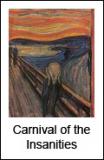The Latest Protected Minority
In the case of Lazano, et al v Hazleton (pdf), a new protected minority has been declared. It isn't Mexican Americans, Hispanics, illegal immigrants, or people with a certain look to them. This protected class is much harder to spot, and certainly includes people who are far more dangerous than the average Central American here to find work.
While I have no wish to attack Judge Munley personally or to impugn his character, I think he's made a mistake. Whether the Clinton appointee did so out of dispassionate legal reasoning or from some philosophical conviction is unclear to me. The judge has ruled that while local law enforcement officials can enforce Federal laws, local laws can't make it more difficult for people to skirt them.
Analyzing a judge's attitude from a decision is difficult, because it's easy to read in bias where none exists. And I'm not a lawyer, so I may be naively, ineptly, and completely wrong in a dozen different ways. But in the first footnote of the decision, the judge says
1The parties vary in their use of the terms “illegal alien,” “unauthorized alien,” “illegal immigrant” and “undocumented alien.” We will use the terms interchangeably.
The judge soon afterward notes that the ordinance defined "illegal alien" as someone having an "unlawful presence" in the country as defined by 8 USC §1101. But that section defines "immigrant" as a certain kind of alien, rather than specifically saying which kind of alien is present lawfully and which is not.
So he summarize immigration law, concluding:
A third category of aliens present in the country are “undocumented aliens” who lack lawful immigration status. These aliens may have overstayed their time in the United States or entered the country illegally. (Id. at 113). The number of these individuals is approximately twelve million. (Id.). Hazleton’s use of the term “illegal alien” evidently is aimed at these individuals.
Perhaps this conflict in terminology is just an artifact of the judge doing the low-level work at one time and the footnotes at another, but he seems to show a definite preference for the term "undocumented".
And of what use is mentioning the "12 million" number?
He then assesses the standing of each plaintiff (some of whom were illegals, some not). He does so by the Federal Rules of Civil Procedure for standing, which he summarizes. However, for each of the defendants (though I skimmed some here) he assumes that it was the Hazleton ordinance that caused the injury to the plaintiffs, not the Federal law in which they or their prospective customers were in violation.
The judge appears to have adduced from the evidence at trial that the Hazleton ordinance "created a climate of fear" among legitimate businesses and legal aliens. He returns to that again and again in reasoning that the ordinance, not the Federal law, is to blame for the plaintiff's troubles. He does so in part because:
... The business-owner plaintiffs do not complain that the ordinances limit their ability to sell products to and hire illegal aliens. They complain that the City’s ordinances damage them by hindering the operation of their businesses and by requiring them to seek immigration information from employees in a way that violates federal law.
And there is the nugget of it: he agrees with the plaintiffs that the locality can't have an ordinance which discriminates based on compliance with Federal law.
So we have a new protected class: Federal lawbreakers.
Sphere: Related Content
 This amount of arrogance, the sheer impardonable pretension, is bound to be popular.
This amount of arrogance, the sheer impardonable pretension, is bound to be popular.










No comments:
Post a Comment